Globalization and Economic Development
VerifiedAdded on 2020/05/28
|10
|2119
|137
AI Summary
This assignment explores the complex relationship between globalization and economic development. Students are tasked with analyzing the positive and negative impacts of globalization on underdeveloped markets, emphasizing the role of emerging markets in driving global economic growth. The discussion should also encompass ethical considerations for businesses operating in a globalized environment, stressing the importance of responsible resource management and sustainable practices. Finally, students are encouraged to consider the implications of terrorism and illegal activities on global economic stability.
Contribute Materials
Your contribution can guide someone’s learning journey. Share your
documents today.

Running head: TAYLORISM AND GLOBALISATION
Taylorism and Globalisation
Name of the Student:
Name of the University:
Author Note:
Taylorism and Globalisation
Name of the Student:
Name of the University:
Author Note:
Secure Best Marks with AI Grader
Need help grading? Try our AI Grader for instant feedback on your assignments.
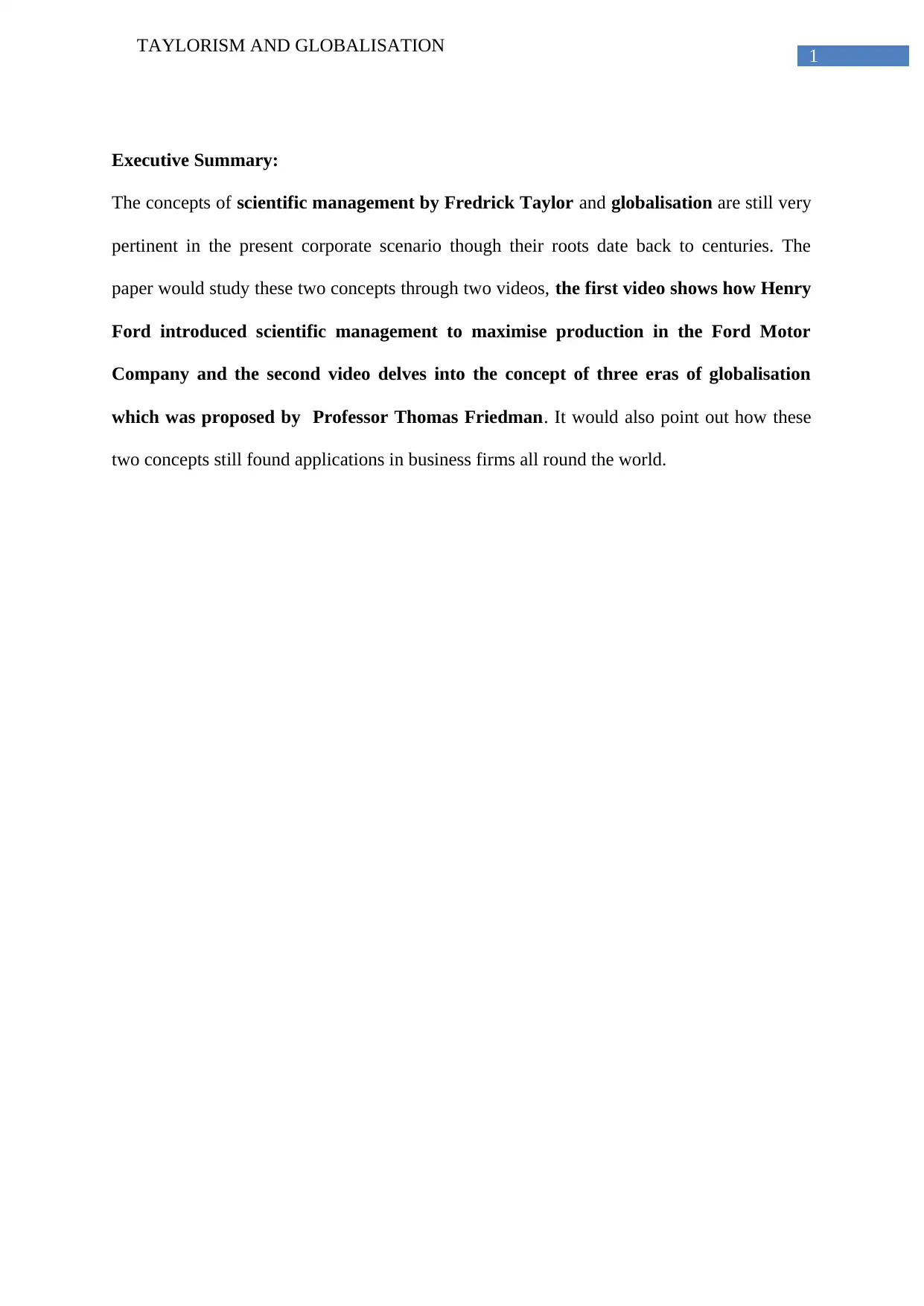
1
TAYLORISM AND GLOBALISATION
Executive Summary:
The concepts of scientific management by Fredrick Taylor and globalisation are still very
pertinent in the present corporate scenario though their roots date back to centuries. The
paper would study these two concepts through two videos, the first video shows how Henry
Ford introduced scientific management to maximise production in the Ford Motor
Company and the second video delves into the concept of three eras of globalisation
which was proposed by Professor Thomas Friedman. It would also point out how these
two concepts still found applications in business firms all round the world.
TAYLORISM AND GLOBALISATION
Executive Summary:
The concepts of scientific management by Fredrick Taylor and globalisation are still very
pertinent in the present corporate scenario though their roots date back to centuries. The
paper would study these two concepts through two videos, the first video shows how Henry
Ford introduced scientific management to maximise production in the Ford Motor
Company and the second video delves into the concept of three eras of globalisation
which was proposed by Professor Thomas Friedman. It would also point out how these
two concepts still found applications in business firms all round the world.
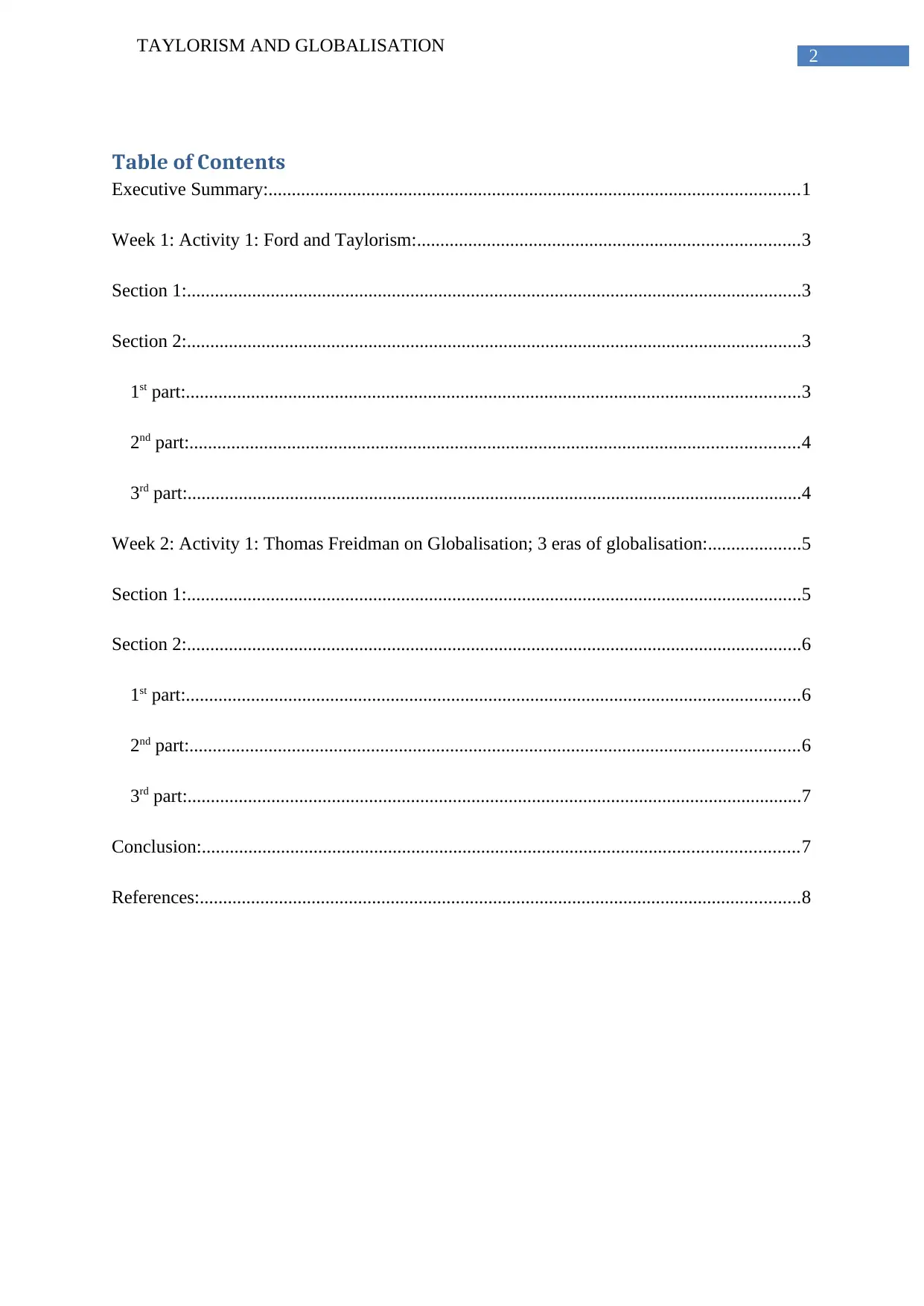
2
TAYLORISM AND GLOBALISATION
Table of Contents
Executive Summary:..................................................................................................................1
Week 1: Activity 1: Ford and Taylorism:..................................................................................3
Section 1:....................................................................................................................................3
Section 2:....................................................................................................................................3
1st part:....................................................................................................................................3
2nd part:...................................................................................................................................4
3rd part:....................................................................................................................................4
Week 2: Activity 1: Thomas Freidman on Globalisation; 3 eras of globalisation:....................5
Section 1:....................................................................................................................................5
Section 2:....................................................................................................................................6
1st part:....................................................................................................................................6
2nd part:...................................................................................................................................6
3rd part:....................................................................................................................................7
Conclusion:................................................................................................................................7
References:.................................................................................................................................8
TAYLORISM AND GLOBALISATION
Table of Contents
Executive Summary:..................................................................................................................1
Week 1: Activity 1: Ford and Taylorism:..................................................................................3
Section 1:....................................................................................................................................3
Section 2:....................................................................................................................................3
1st part:....................................................................................................................................3
2nd part:...................................................................................................................................4
3rd part:....................................................................................................................................4
Week 2: Activity 1: Thomas Freidman on Globalisation; 3 eras of globalisation:....................5
Section 1:....................................................................................................................................5
Section 2:....................................................................................................................................6
1st part:....................................................................................................................................6
2nd part:...................................................................................................................................6
3rd part:....................................................................................................................................7
Conclusion:................................................................................................................................7
References:.................................................................................................................................8
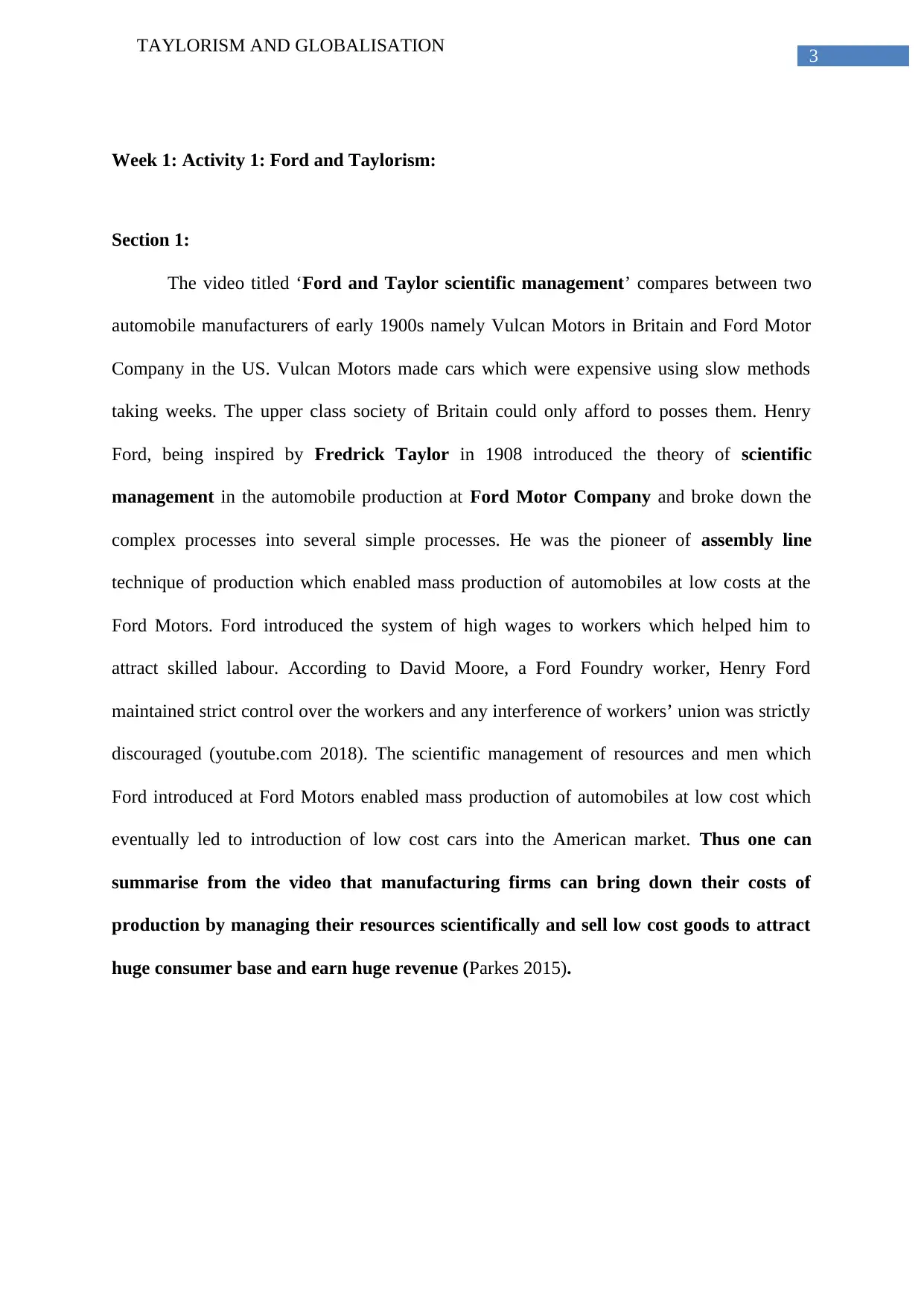
3
TAYLORISM AND GLOBALISATION
Week 1: Activity 1: Ford and Taylorism:
Section 1:
The video titled ‘Ford and Taylor scientific management’ compares between two
automobile manufacturers of early 1900s namely Vulcan Motors in Britain and Ford Motor
Company in the US. Vulcan Motors made cars which were expensive using slow methods
taking weeks. The upper class society of Britain could only afford to posses them. Henry
Ford, being inspired by Fredrick Taylor in 1908 introduced the theory of scientific
management in the automobile production at Ford Motor Company and broke down the
complex processes into several simple processes. He was the pioneer of assembly line
technique of production which enabled mass production of automobiles at low costs at the
Ford Motors. Ford introduced the system of high wages to workers which helped him to
attract skilled labour. According to David Moore, a Ford Foundry worker, Henry Ford
maintained strict control over the workers and any interference of workers’ union was strictly
discouraged (youtube.com 2018). The scientific management of resources and men which
Ford introduced at Ford Motors enabled mass production of automobiles at low cost which
eventually led to introduction of low cost cars into the American market. Thus one can
summarise from the video that manufacturing firms can bring down their costs of
production by managing their resources scientifically and sell low cost goods to attract
huge consumer base and earn huge revenue (Parkes 2015).
TAYLORISM AND GLOBALISATION
Week 1: Activity 1: Ford and Taylorism:
Section 1:
The video titled ‘Ford and Taylor scientific management’ compares between two
automobile manufacturers of early 1900s namely Vulcan Motors in Britain and Ford Motor
Company in the US. Vulcan Motors made cars which were expensive using slow methods
taking weeks. The upper class society of Britain could only afford to posses them. Henry
Ford, being inspired by Fredrick Taylor in 1908 introduced the theory of scientific
management in the automobile production at Ford Motor Company and broke down the
complex processes into several simple processes. He was the pioneer of assembly line
technique of production which enabled mass production of automobiles at low costs at the
Ford Motors. Ford introduced the system of high wages to workers which helped him to
attract skilled labour. According to David Moore, a Ford Foundry worker, Henry Ford
maintained strict control over the workers and any interference of workers’ union was strictly
discouraged (youtube.com 2018). The scientific management of resources and men which
Ford introduced at Ford Motors enabled mass production of automobiles at low cost which
eventually led to introduction of low cost cars into the American market. Thus one can
summarise from the video that manufacturing firms can bring down their costs of
production by managing their resources scientifically and sell low cost goods to attract
huge consumer base and earn huge revenue (Parkes 2015).
Secure Best Marks with AI Grader
Need help grading? Try our AI Grader for instant feedback on your assignments.

4
TAYLORISM AND GLOBALISATION
Section 2:
1st part:
Workers in Australia, America and Europe would accept Taylorism and its scientific
management of resources. The small firms in these markets today have to face the challenges
of cost cutting and sustainability which necessitate them to manage their resources more
efficiently to reduce wastage. These firms can adopt Taylor’s system of scientific
management to allocate their resources scientifically, ensure high productivity and reduce
losses they suffer due to wastage of resources (Luning et al. 2015).
2nd part:
Taylorism finds applications in the designs of the scripts used in the call centres. The
scripts in the call centres today are either in digital formats or physical formats in which
questions are arranged in planned manners in order to ensure maximum positive responses
from customers. The employees in these call centres are monitored to ensure that they
perform efficiently. The supervisors train underperforming callers to enhance their
competencies. Moreover, the supervisors monitor the calls digitally to ensure that callers do
not waste time asking unnecessary questions to customers (Gandomi and Haider 2015). This
analysis shows that the call centres manage the questions on the scripts scientifically to
ensure that the callers are able to get maximum productivity from them. Thus, one can infer
from the discussion that the call centres scripts use Taylorism to a great extent to ensure
high productivity.
3rd part:
The ideas of Fordism and Taylorism depicted in the video dates back to a hundred
years and may out of order according to some but there are still firms many parts of the world
which require these ideas to survive. The small firms in markets like Africa and Asia today
TAYLORISM AND GLOBALISATION
Section 2:
1st part:
Workers in Australia, America and Europe would accept Taylorism and its scientific
management of resources. The small firms in these markets today have to face the challenges
of cost cutting and sustainability which necessitate them to manage their resources more
efficiently to reduce wastage. These firms can adopt Taylor’s system of scientific
management to allocate their resources scientifically, ensure high productivity and reduce
losses they suffer due to wastage of resources (Luning et al. 2015).
2nd part:
Taylorism finds applications in the designs of the scripts used in the call centres. The
scripts in the call centres today are either in digital formats or physical formats in which
questions are arranged in planned manners in order to ensure maximum positive responses
from customers. The employees in these call centres are monitored to ensure that they
perform efficiently. The supervisors train underperforming callers to enhance their
competencies. Moreover, the supervisors monitor the calls digitally to ensure that callers do
not waste time asking unnecessary questions to customers (Gandomi and Haider 2015). This
analysis shows that the call centres manage the questions on the scripts scientifically to
ensure that the callers are able to get maximum productivity from them. Thus, one can infer
from the discussion that the call centres scripts use Taylorism to a great extent to ensure
high productivity.
3rd part:
The ideas of Fordism and Taylorism depicted in the video dates back to a hundred
years and may out of order according to some but there are still firms many parts of the world
which require these ideas to survive. The small firms in markets like Africa and Asia today
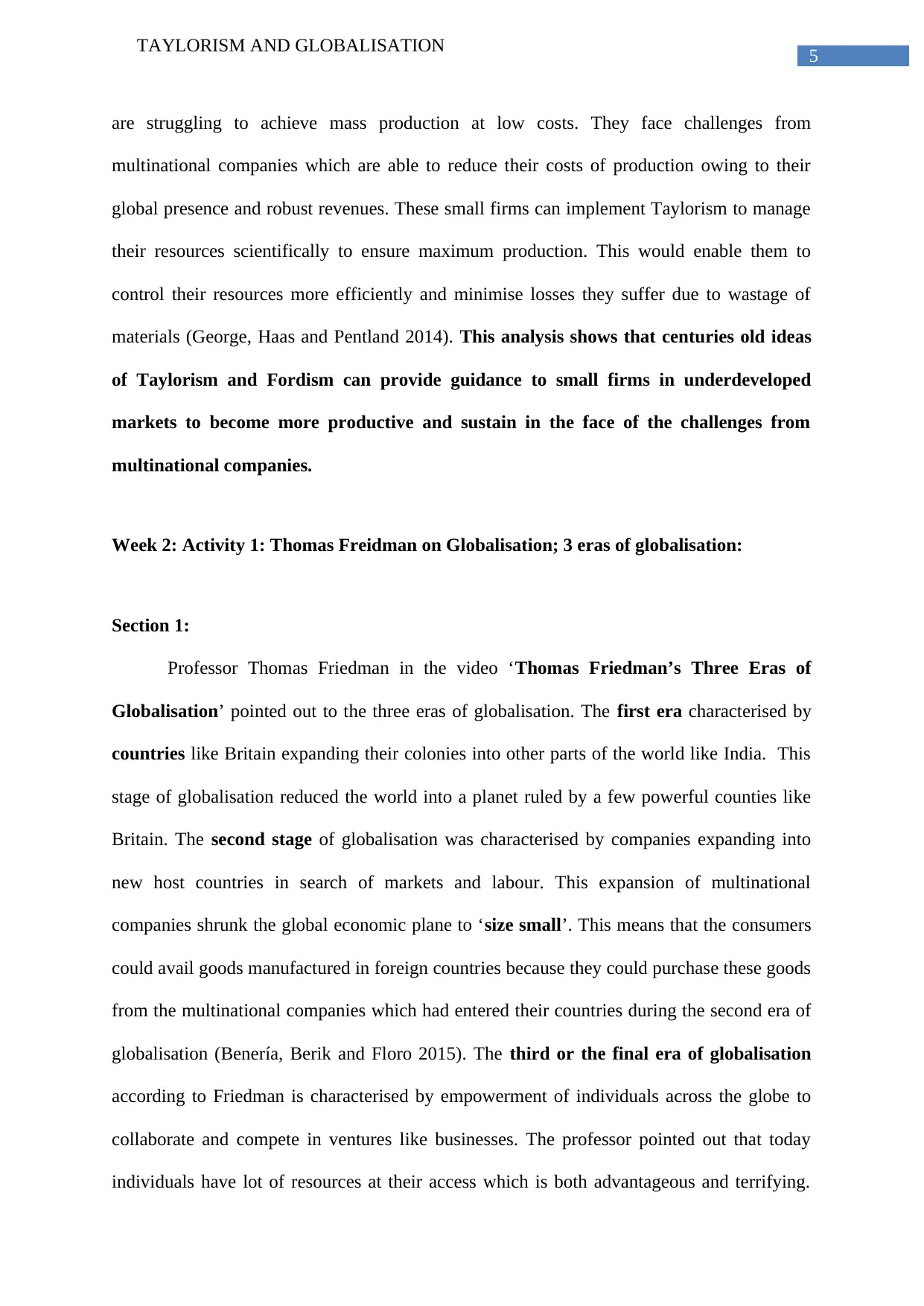
5
TAYLORISM AND GLOBALISATION
are struggling to achieve mass production at low costs. They face challenges from
multinational companies which are able to reduce their costs of production owing to their
global presence and robust revenues. These small firms can implement Taylorism to manage
their resources scientifically to ensure maximum production. This would enable them to
control their resources more efficiently and minimise losses they suffer due to wastage of
materials (George, Haas and Pentland 2014). This analysis shows that centuries old ideas
of Taylorism and Fordism can provide guidance to small firms in underdeveloped
markets to become more productive and sustain in the face of the challenges from
multinational companies.
Week 2: Activity 1: Thomas Freidman on Globalisation; 3 eras of globalisation:
Section 1:
Professor Thomas Friedman in the video ‘Thomas Friedman’s Three Eras of
Globalisation’ pointed out to the three eras of globalisation. The first era characterised by
countries like Britain expanding their colonies into other parts of the world like India. This
stage of globalisation reduced the world into a planet ruled by a few powerful counties like
Britain. The second stage of globalisation was characterised by companies expanding into
new host countries in search of markets and labour. This expansion of multinational
companies shrunk the global economic plane to ‘size small’. This means that the consumers
could avail goods manufactured in foreign countries because they could purchase these goods
from the multinational companies which had entered their countries during the second era of
globalisation (Benería, Berik and Floro 2015). The third or the final era of globalisation
according to Friedman is characterised by empowerment of individuals across the globe to
collaborate and compete in ventures like businesses. The professor pointed out that today
individuals have lot of resources at their access which is both advantageous and terrifying.
TAYLORISM AND GLOBALISATION
are struggling to achieve mass production at low costs. They face challenges from
multinational companies which are able to reduce their costs of production owing to their
global presence and robust revenues. These small firms can implement Taylorism to manage
their resources scientifically to ensure maximum production. This would enable them to
control their resources more efficiently and minimise losses they suffer due to wastage of
materials (George, Haas and Pentland 2014). This analysis shows that centuries old ideas
of Taylorism and Fordism can provide guidance to small firms in underdeveloped
markets to become more productive and sustain in the face of the challenges from
multinational companies.
Week 2: Activity 1: Thomas Freidman on Globalisation; 3 eras of globalisation:
Section 1:
Professor Thomas Friedman in the video ‘Thomas Friedman’s Three Eras of
Globalisation’ pointed out to the three eras of globalisation. The first era characterised by
countries like Britain expanding their colonies into other parts of the world like India. This
stage of globalisation reduced the world into a planet ruled by a few powerful counties like
Britain. The second stage of globalisation was characterised by companies expanding into
new host countries in search of markets and labour. This expansion of multinational
companies shrunk the global economic plane to ‘size small’. This means that the consumers
could avail goods manufactured in foreign countries because they could purchase these goods
from the multinational companies which had entered their countries during the second era of
globalisation (Benería, Berik and Floro 2015). The third or the final era of globalisation
according to Friedman is characterised by empowerment of individuals across the globe to
collaborate and compete in ventures like businesses. The professor pointed out that today
individuals have lot of resources at their access which is both advantageous and terrifying.
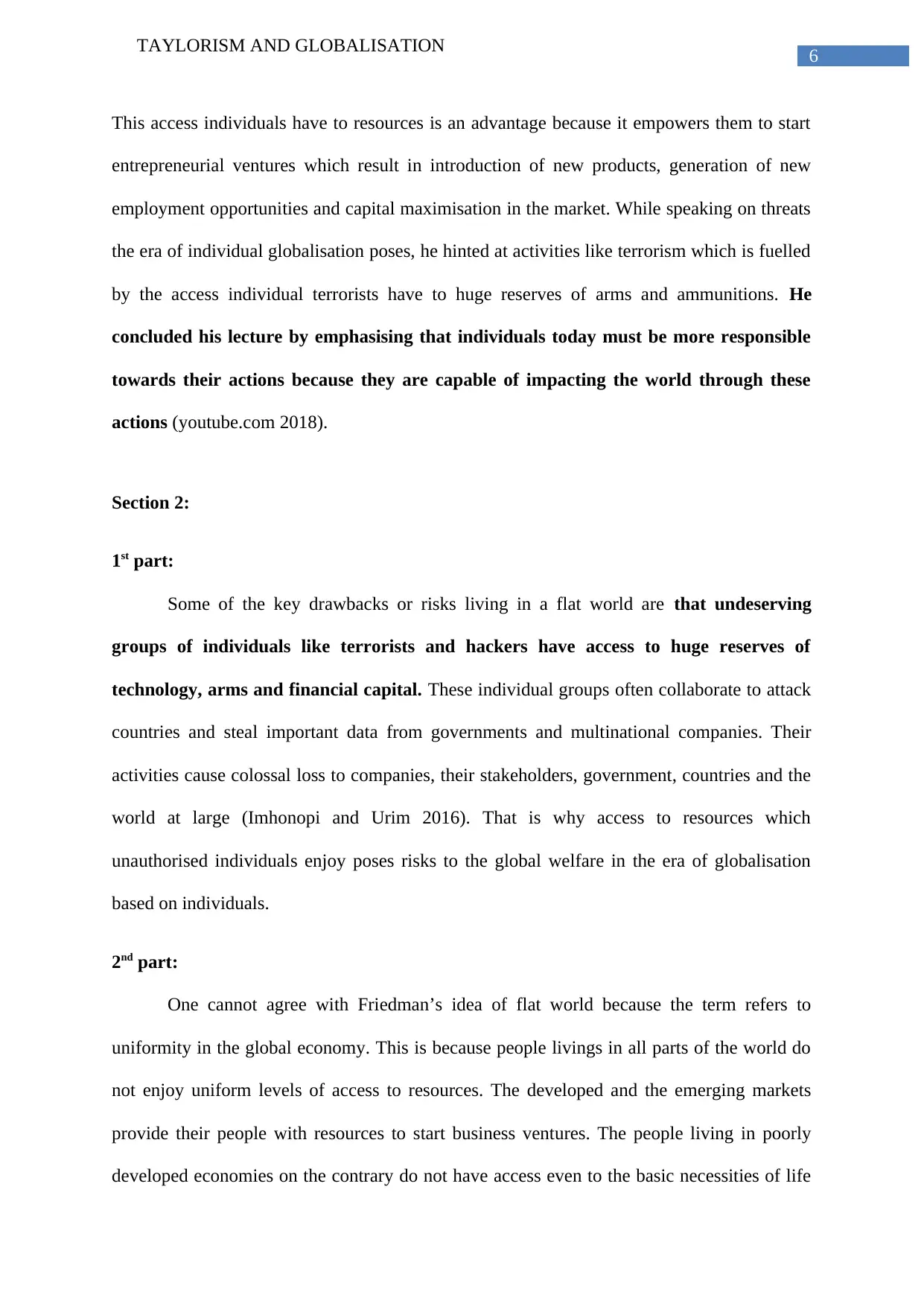
6
TAYLORISM AND GLOBALISATION
This access individuals have to resources is an advantage because it empowers them to start
entrepreneurial ventures which result in introduction of new products, generation of new
employment opportunities and capital maximisation in the market. While speaking on threats
the era of individual globalisation poses, he hinted at activities like terrorism which is fuelled
by the access individual terrorists have to huge reserves of arms and ammunitions. He
concluded his lecture by emphasising that individuals today must be more responsible
towards their actions because they are capable of impacting the world through these
actions (youtube.com 2018).
Section 2:
1st part:
Some of the key drawbacks or risks living in a flat world are that undeserving
groups of individuals like terrorists and hackers have access to huge reserves of
technology, arms and financial capital. These individual groups often collaborate to attack
countries and steal important data from governments and multinational companies. Their
activities cause colossal loss to companies, their stakeholders, government, countries and the
world at large (Imhonopi and Urim 2016). That is why access to resources which
unauthorised individuals enjoy poses risks to the global welfare in the era of globalisation
based on individuals.
2nd part:
One cannot agree with Friedman’s idea of flat world because the term refers to
uniformity in the global economy. This is because people livings in all parts of the world do
not enjoy uniform levels of access to resources. The developed and the emerging markets
provide their people with resources to start business ventures. The people living in poorly
developed economies on the contrary do not have access even to the basic necessities of life
TAYLORISM AND GLOBALISATION
This access individuals have to resources is an advantage because it empowers them to start
entrepreneurial ventures which result in introduction of new products, generation of new
employment opportunities and capital maximisation in the market. While speaking on threats
the era of individual globalisation poses, he hinted at activities like terrorism which is fuelled
by the access individual terrorists have to huge reserves of arms and ammunitions. He
concluded his lecture by emphasising that individuals today must be more responsible
towards their actions because they are capable of impacting the world through these
actions (youtube.com 2018).
Section 2:
1st part:
Some of the key drawbacks or risks living in a flat world are that undeserving
groups of individuals like terrorists and hackers have access to huge reserves of
technology, arms and financial capital. These individual groups often collaborate to attack
countries and steal important data from governments and multinational companies. Their
activities cause colossal loss to companies, their stakeholders, government, countries and the
world at large (Imhonopi and Urim 2016). That is why access to resources which
unauthorised individuals enjoy poses risks to the global welfare in the era of globalisation
based on individuals.
2nd part:
One cannot agree with Friedman’s idea of flat world because the term refers to
uniformity in the global economy. This is because people livings in all parts of the world do
not enjoy uniform levels of access to resources. The developed and the emerging markets
provide their people with resources to start business ventures. The people living in poorly
developed economies on the contrary do not have access even to the basic necessities of life
Paraphrase This Document
Need a fresh take? Get an instant paraphrase of this document with our AI Paraphraser
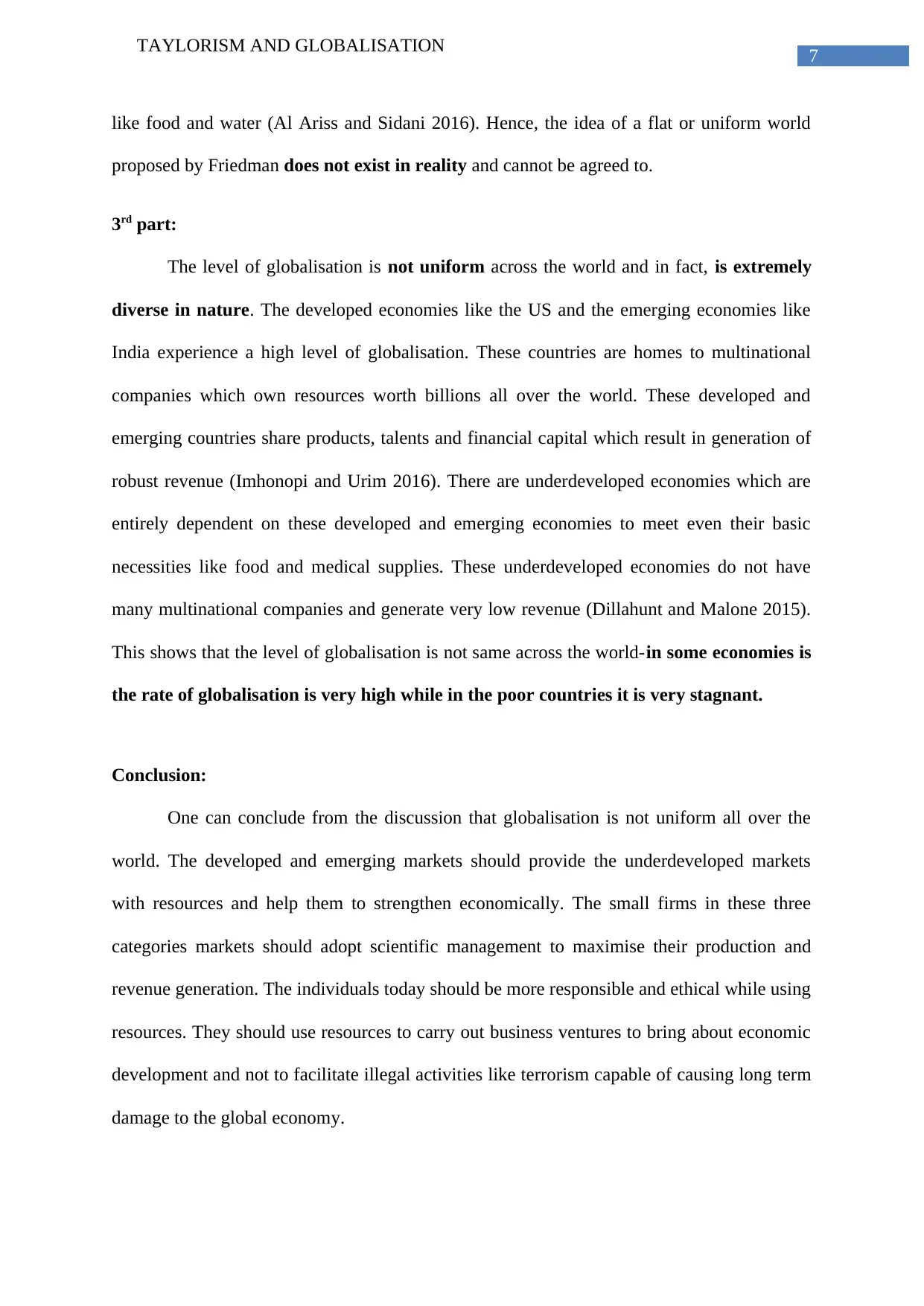
7
TAYLORISM AND GLOBALISATION
like food and water (Al Ariss and Sidani 2016). Hence, the idea of a flat or uniform world
proposed by Friedman does not exist in reality and cannot be agreed to.
3rd part:
The level of globalisation is not uniform across the world and in fact, is extremely
diverse in nature. The developed economies like the US and the emerging economies like
India experience a high level of globalisation. These countries are homes to multinational
companies which own resources worth billions all over the world. These developed and
emerging countries share products, talents and financial capital which result in generation of
robust revenue (Imhonopi and Urim 2016). There are underdeveloped economies which are
entirely dependent on these developed and emerging economies to meet even their basic
necessities like food and medical supplies. These underdeveloped economies do not have
many multinational companies and generate very low revenue (Dillahunt and Malone 2015).
This shows that the level of globalisation is not same across the world-in some economies is
the rate of globalisation is very high while in the poor countries it is very stagnant.
Conclusion:
One can conclude from the discussion that globalisation is not uniform all over the
world. The developed and emerging markets should provide the underdeveloped markets
with resources and help them to strengthen economically. The small firms in these three
categories markets should adopt scientific management to maximise their production and
revenue generation. The individuals today should be more responsible and ethical while using
resources. They should use resources to carry out business ventures to bring about economic
development and not to facilitate illegal activities like terrorism capable of causing long term
damage to the global economy.
TAYLORISM AND GLOBALISATION
like food and water (Al Ariss and Sidani 2016). Hence, the idea of a flat or uniform world
proposed by Friedman does not exist in reality and cannot be agreed to.
3rd part:
The level of globalisation is not uniform across the world and in fact, is extremely
diverse in nature. The developed economies like the US and the emerging economies like
India experience a high level of globalisation. These countries are homes to multinational
companies which own resources worth billions all over the world. These developed and
emerging countries share products, talents and financial capital which result in generation of
robust revenue (Imhonopi and Urim 2016). There are underdeveloped economies which are
entirely dependent on these developed and emerging economies to meet even their basic
necessities like food and medical supplies. These underdeveloped economies do not have
many multinational companies and generate very low revenue (Dillahunt and Malone 2015).
This shows that the level of globalisation is not same across the world-in some economies is
the rate of globalisation is very high while in the poor countries it is very stagnant.
Conclusion:
One can conclude from the discussion that globalisation is not uniform all over the
world. The developed and emerging markets should provide the underdeveloped markets
with resources and help them to strengthen economically. The small firms in these three
categories markets should adopt scientific management to maximise their production and
revenue generation. The individuals today should be more responsible and ethical while using
resources. They should use resources to carry out business ventures to bring about economic
development and not to facilitate illegal activities like terrorism capable of causing long term
damage to the global economy.
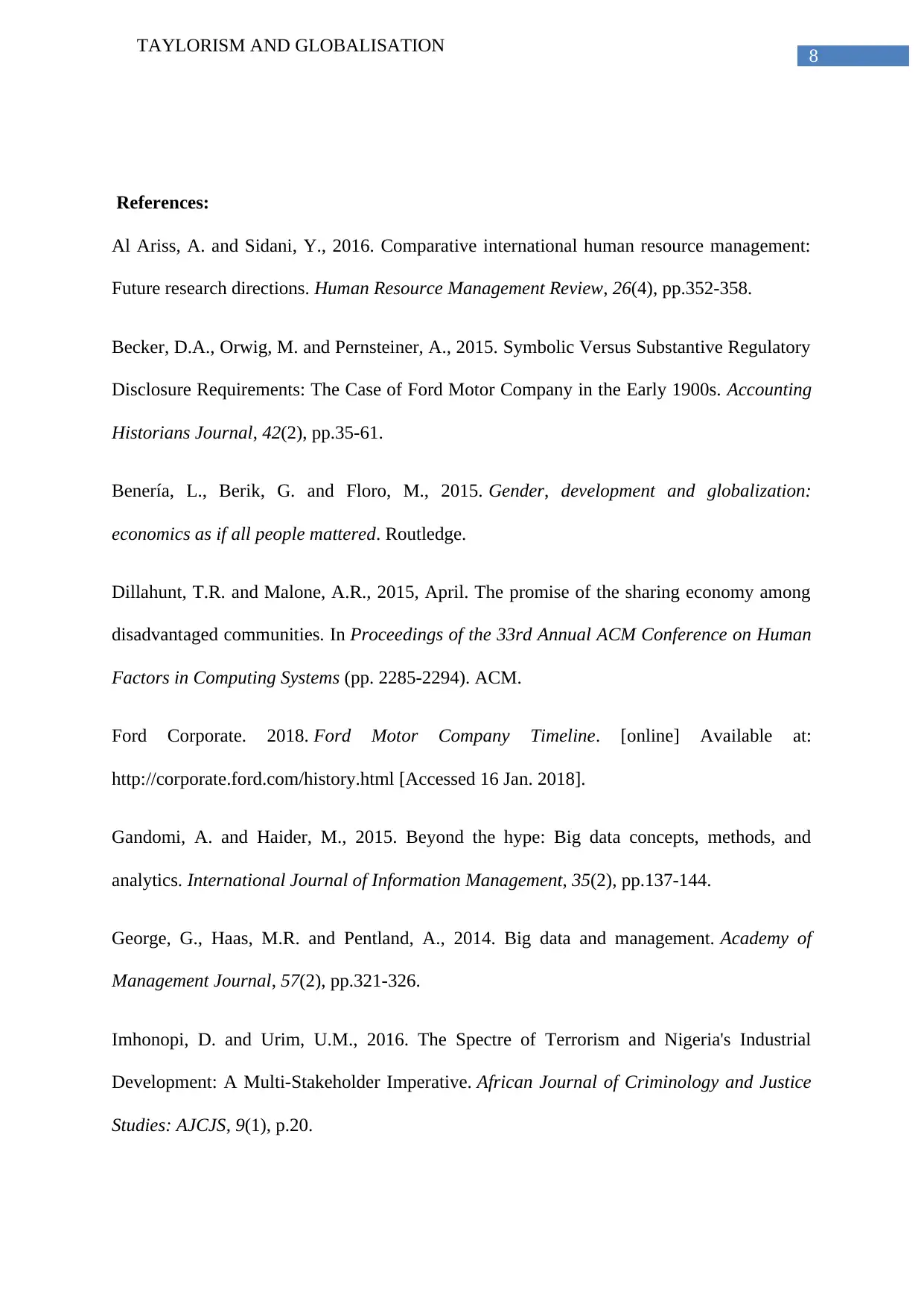
8
TAYLORISM AND GLOBALISATION
References:
Al Ariss, A. and Sidani, Y., 2016. Comparative international human resource management:
Future research directions. Human Resource Management Review, 26(4), pp.352-358.
Becker, D.A., Orwig, M. and Pernsteiner, A., 2015. Symbolic Versus Substantive Regulatory
Disclosure Requirements: The Case of Ford Motor Company in the Early 1900s. Accounting
Historians Journal, 42(2), pp.35-61.
Benería, L., Berik, G. and Floro, M., 2015. Gender, development and globalization:
economics as if all people mattered. Routledge.
Dillahunt, T.R. and Malone, A.R., 2015, April. The promise of the sharing economy among
disadvantaged communities. In Proceedings of the 33rd Annual ACM Conference on Human
Factors in Computing Systems (pp. 2285-2294). ACM.
Ford Corporate. 2018. Ford Motor Company Timeline. [online] Available at:
http://corporate.ford.com/history.html [Accessed 16 Jan. 2018].
Gandomi, A. and Haider, M., 2015. Beyond the hype: Big data concepts, methods, and
analytics. International Journal of Information Management, 35(2), pp.137-144.
George, G., Haas, M.R. and Pentland, A., 2014. Big data and management. Academy of
Management Journal, 57(2), pp.321-326.
Imhonopi, D. and Urim, U.M., 2016. The Spectre of Terrorism and Nigeria's Industrial
Development: A Multi-Stakeholder Imperative. African Journal of Criminology and Justice
Studies: AJCJS, 9(1), p.20.
TAYLORISM AND GLOBALISATION
References:
Al Ariss, A. and Sidani, Y., 2016. Comparative international human resource management:
Future research directions. Human Resource Management Review, 26(4), pp.352-358.
Becker, D.A., Orwig, M. and Pernsteiner, A., 2015. Symbolic Versus Substantive Regulatory
Disclosure Requirements: The Case of Ford Motor Company in the Early 1900s. Accounting
Historians Journal, 42(2), pp.35-61.
Benería, L., Berik, G. and Floro, M., 2015. Gender, development and globalization:
economics as if all people mattered. Routledge.
Dillahunt, T.R. and Malone, A.R., 2015, April. The promise of the sharing economy among
disadvantaged communities. In Proceedings of the 33rd Annual ACM Conference on Human
Factors in Computing Systems (pp. 2285-2294). ACM.
Ford Corporate. 2018. Ford Motor Company Timeline. [online] Available at:
http://corporate.ford.com/history.html [Accessed 16 Jan. 2018].
Gandomi, A. and Haider, M., 2015. Beyond the hype: Big data concepts, methods, and
analytics. International Journal of Information Management, 35(2), pp.137-144.
George, G., Haas, M.R. and Pentland, A., 2014. Big data and management. Academy of
Management Journal, 57(2), pp.321-326.
Imhonopi, D. and Urim, U.M., 2016. The Spectre of Terrorism and Nigeria's Industrial
Development: A Multi-Stakeholder Imperative. African Journal of Criminology and Justice
Studies: AJCJS, 9(1), p.20.
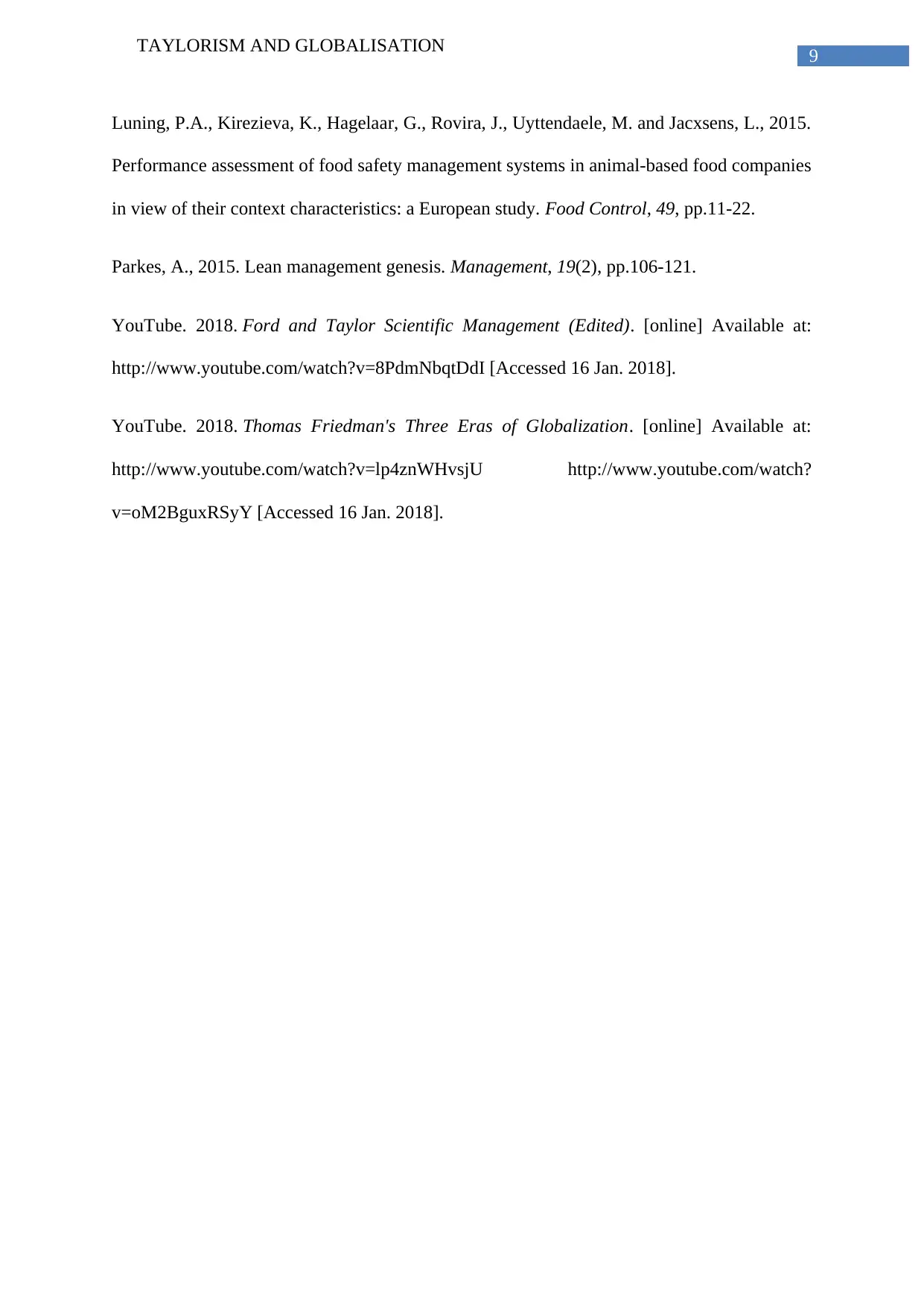
9
TAYLORISM AND GLOBALISATION
Luning, P.A., Kirezieva, K., Hagelaar, G., Rovira, J., Uyttendaele, M. and Jacxsens, L., 2015.
Performance assessment of food safety management systems in animal-based food companies
in view of their context characteristics: a European study. Food Control, 49, pp.11-22.
Parkes, A., 2015. Lean management genesis. Management, 19(2), pp.106-121.
YouTube. 2018. Ford and Taylor Scientific Management (Edited). [online] Available at:
http://www.youtube.com/watch?v=8PdmNbqtDdI [Accessed 16 Jan. 2018].
YouTube. 2018. Thomas Friedman's Three Eras of Globalization. [online] Available at:
http://www.youtube.com/watch?v=lp4znWHvsjU http://www.youtube.com/watch?
v=oM2BguxRSyY [Accessed 16 Jan. 2018].
TAYLORISM AND GLOBALISATION
Luning, P.A., Kirezieva, K., Hagelaar, G., Rovira, J., Uyttendaele, M. and Jacxsens, L., 2015.
Performance assessment of food safety management systems in animal-based food companies
in view of their context characteristics: a European study. Food Control, 49, pp.11-22.
Parkes, A., 2015. Lean management genesis. Management, 19(2), pp.106-121.
YouTube. 2018. Ford and Taylor Scientific Management (Edited). [online] Available at:
http://www.youtube.com/watch?v=8PdmNbqtDdI [Accessed 16 Jan. 2018].
YouTube. 2018. Thomas Friedman's Three Eras of Globalization. [online] Available at:
http://www.youtube.com/watch?v=lp4znWHvsjU http://www.youtube.com/watch?
v=oM2BguxRSyY [Accessed 16 Jan. 2018].
1 out of 10
Related Documents
Your All-in-One AI-Powered Toolkit for Academic Success.
+13062052269
info@desklib.com
Available 24*7 on WhatsApp / Email
![[object Object]](/_next/static/media/star-bottom.7253800d.svg)
Unlock your academic potential
© 2024 | Zucol Services PVT LTD | All rights reserved.




